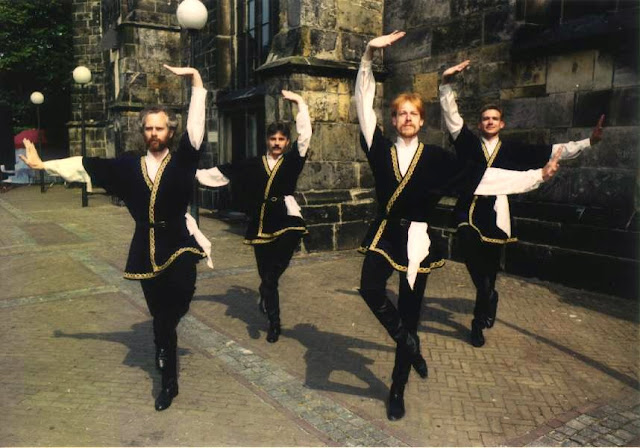Hello all,
Today i will talk a bit about the women's Costume of the central Dalmatian Coast. There are several variants of this costume, but I have more information on the what is considered the daily costume of Split than any of the others, so I will cover it in more detail. The formal 'Town Costume' which is more well known, will be the subject of my next posting.
This costume first developed in a village on the very outskirts of Split called Veli Varoš, but has been adopted by the town dwellers today as well. The photo above shows one of the festive or dress versions of the costume on the right and the 'daily' costume on the left. Here is another photo of the everyday costume. The pad on her head is so that she can carry loads on it.
Here is a rear view of both the daily and formal costume of Split.
This outfit is quite typical of the woman's costumes of the central Adriatic coast. There are similar costumes worn, among other places, on Otok Pag,
in Vrsi,
in Pakoštane,
on Otok Murter,
In Omiš,
and even in Boka Kotorska, a Croatian enclave on the coast of Montenegro. The jacket is an optional piece of clothing with all of these costumes.
Under the influence of city dress, a petticoat, the šotana, is worn over the chemise. This is also of linen. It is long, full, and has a couple of horizontal tucks.
In Split, again unlike Pag, Pakoštan or Murter,but like Omiš, the bodice is seperate from the skirt. It is called korpet, has a high neckline and overlaps in front. For daily wear it is made of simple or even home-woven cloth.
Notice the round silver buttons, typical of much of central Dalmatia. These were especially associated with Šibenik, and may be small or large, simple or very fancy. Similar buttons are found in the north of Sardinia as well.
The skirt called brnica, is ankle length, tends to be dark in color and is finely pleated. If you look closely at the skirt on the right, you will see that it is woven in narrow stripes.
The front of the skirt, which is covered by the apron, is not pleated. This is very common in Folk Dress. The skirt is quite full, about 4.5 meters or so.

An apron is always worn with this outfit. There seems to be a preference for quiet browns and dark colors, with stripes woven into the cloth, ribbons sewn on and many horizontal tucks, after which the entire apron is pleated.
A small scarf may be worn over the shoulders.
This costume is worn with high shoes and knit stockings
A wide array of elaborate jewelry is worn in this region, but the daily costume of Split generally has little accessorization. The formal or festive costume is another matter.
I hope you have found this interesting. I find that most folk costumes are quite attractive.
Feel
free to contact me with requests for research. I hope to eventually
cover all of Europe and the Former Russian Empire/Soviet Union. I also
gratefully accept tips on source materials which i may not have. I also
accept commissions to research/design, sew, and/or embroider costumes or
other items for groups or individuals. I also choreograph and teach
folk dance.
Roman K.
Source Material:
Ilda Vidovic-Begonja, 'Narodna Nošnja Splita', Zagreb, 1988
Ivankovic & Sumenic, 'Croatian National Costumes', Zagreb, 2001
Vladimir Kirin, 'Narodne Nošnje Jugoslavije - Hrvatska', Zagreb, 1986Ribaric/Szenczi, 'Vezak Vezla - Croatian Folk Embroidery', Zagreb, 1973
Jelka Ribaric et al, 'The Folk Costumes of Croatia', Zagreb, 1975
Walter Kolar, 'Croatians - Costumes they Wear', Pittsburgh, 1975
Nikola Pantelic, 'Traditional Arts and Crafts in Yugoslavia', Belgrade, 1984
Vladimir Salopek, 'Folk Costumes and Dances of Yugoslavia, Zagreb, 1987
Mariana Gusic, 'Traditional Femole [sic] Headgear in Croatian Folk Costume', Zagreb
Postcards in personal collection




















































































